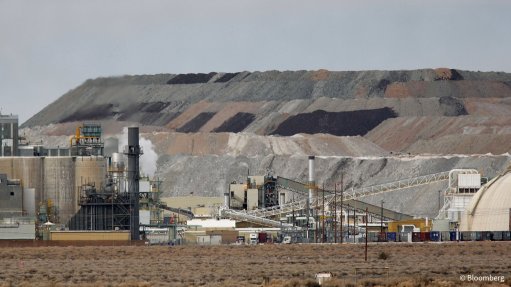The synapses of the Distributed Control System
This article has been supplied.
By Kobus Vermeulen, Direct Sales Executive, Process Automation at Schneider Electric
What is the body without a brain? An empty vessel, uncoordinated and purposeless. The same can be said about industrial operations which require a DCS (Distributed Control System) to – in real-time - coordinate and control its process subsystems.
Like the brain, a DCS’ is a multitasking maestro, controlling and coordinating complex processes in a myriad of industrial setting such as large manufacturing plants, providing valuable top-down control.
The DCS communicates with subsystems such as sensors and other data collection devices, interpreting production trends to make automated decision and send instructions to individual controllers, actuators, and other industrial equipment, programmable logic controllers (PLCs), throughout the plant.
It is certainly marketplace that seeing considerable growth. According to research, the DCS Market size was valued at over USD 23.28 Billion in 2023 and is anticipated to reach USD 48.44 Billion by the end of 2036, growing at a CAGR of 5.8% during the forecast period between 2024-2036.
Key to the marketplace’s growth is the continued proliferation and acceptance of loT technologies with DCS. The number of connected loT devices worldwide is projected to reach nearly 76 billion by 2025.
Brainfood for the system
Considering the above, it’s clear, the DCS is growing marketplace. So, what is if one then adds Artificial Intelligence (AI) and Machine Learning (ML) to modern DCSs? For one, it acts as software-based brainfood to the DCS, optimising several key operations such as predictive maintenance, process optimisation, analytics and anomaly detection
A perfect example is predictive maintenance. Traditionally reactive, maintenance addresses issues after it occurs—or based on a scheduled timeline, which often leads to unnecessary downtime or unforeseen breakdowns.
AI and ML algorithms, however, analyse historical and real-time data from DCS sensors to predict potential equipment failures before it happens. This predictive maintenance capability enables industries to strategically schedule maintenance activities which in turn reduce unexpected downtime whilst optimising asset performance.
For instance, in the oil and gas industry, AI algorithms monitor data from pumps, compressors, and other critical equipment. By detecting subtle changes in vibration patterns or temperature, the system can forecast when a piece of equipment might fail, allowing maintenance teams to intervene early. This not only reduces maintenance costs but also enhances operational reliability.
Process optimisation – waste not want not
Industrial processes generate vast amounts of data. When incorporating AI and ML, DCS learns from the generated data, which enables it to, in a real-time, finetune control strategies. This dynamic adjustment of control parameters delivers improved process efficiency, reduced energy consumption, and minimised waste.
As an example, in a plant, the integrated AI system AI can adjust variables such as temperature, pressure, and flow rates based on real-time data, ensuring that the process operates at optimal efficiency which in turn saves on valuable energy, ultimately contributing to environmentally sensitive practices.
Anomaly detection - safeguarding operational integrity
Anomaly detection is another critical area where AI and ML are making a substantial impact. By integrating ML algorithms into a DCS, industries can identify irregularities in process variables, equipment behaviour, or overall system performance. Early detection of these anomalies is crucial for maintaining operational efficiency and preventing potential safety hazards.
In a chemical processing plant, for example, AI-driven DCS can detect deviations from normal operating conditions, such as unexpected pressure spikes or temperature fluctuations. Upon identifying an anomaly, the system can trigger alarms or automatically adjust parameters to mitigate risks, ensuring the process remains safe and efficient.
Addressing cybersecurity challenges
The above are undoubtedly compelling benefits, however, as DCSs become increasingly interconnected, it also become more vulnerable to cybersecurity threats. Primary concerns include cyberattacks, risks associated with legacy systems, interoperability concerns, and insider threats.
These cybersecurity challenges can significantly affect industrial process integrity and security by potentially causing:
•Disruption of operations - cyber-attacks can disrupt industrial processes, leading to downtime, production losses, and safety risks.
•Data breaches - compromised DCS systems can result in unauthorised access to sensitive operational data, leading to confidentiality breaches and intellectual property theft.
•Safety risks - cybersecurity breaches can impact the safety controls and protocols within industrial processes, potentially leading to hazardous situations.
To address these challenges, robust cybersecurity measures such as network segmentation, regular security updates, access control, and employee training are essential to safeguard interconnected DCS systems and ensure the integrity and security of industrial processes.
Article Enquiry
Email Article
Save Article
Feedback
To advertise email advertising@creamermedia.co.za or click here
Announcements
What's On
Subscribe to improve your user experience...
Option 1 (equivalent of R125 a month):
Receive a weekly copy of Creamer Media's Engineering News & Mining Weekly magazine
(print copy for those in South Africa and e-magazine for those outside of South Africa)
Receive daily email newsletters
Access to full search results
Access archive of magazine back copies
Access to Projects in Progress
Access to ONE Research Report of your choice in PDF format
Option 2 (equivalent of R375 a month):
All benefits from Option 1
PLUS
Access to Creamer Media's Research Channel Africa for ALL Research Reports, in PDF format, on various industrial and mining sectors
including Electricity; Water; Energy Transition; Hydrogen; Roads, Rail and Ports; Coal; Gold; Platinum; Battery Metals; etc.
Already a subscriber?
Forgotten your password?
Receive weekly copy of Creamer Media's Engineering News & Mining Weekly magazine (print copy for those in South Africa and e-magazine for those outside of South Africa)
➕
Recieve daily email newsletters
➕
Access to full search results
➕
Access archive of magazine back copies
➕
Access to Projects in Progress
➕
Access to ONE Research Report of your choice in PDF format
RESEARCH CHANNEL AFRICA
R4500 (equivalent of R375 a month)
SUBSCRIBEAll benefits from Option 1
➕
Access to Creamer Media's Research Channel Africa for ALL Research Reports on various industrial and mining sectors, in PDF format, including on:
Electricity
➕
Water
➕
Energy Transition
➕
Hydrogen
➕
Roads, Rail and Ports
➕
Coal
➕
Gold
➕
Platinum
➕
Battery Metals
➕
etc.
Receive all benefits from Option 1 or Option 2 delivered to numerous people at your company
➕
Multiple User names and Passwords for simultaneous log-ins
➕
Intranet integration access to all in your organisation





















